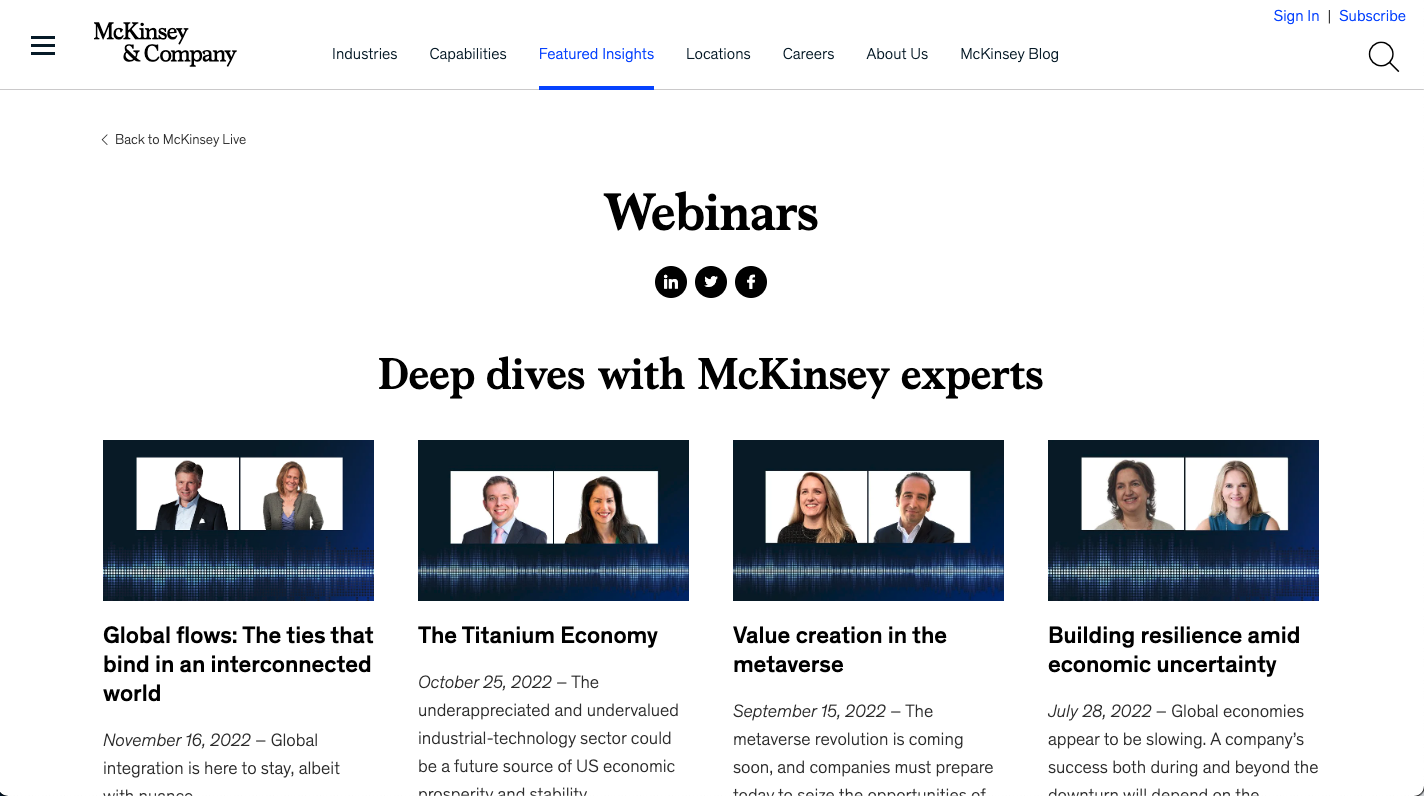Video has come a long way since startling crowds with images of moving trains in the late 19th century. Today, it’s become an omnipresent medium for art, advertisements and everything in between. Whether you’re scrolling through your phone, streaming a movie or just walking past a digital billboard, you’ve likely noticed the power videos have to captivate viewers. But why is that?
One answer might be that we want the fastest, easiest solution. In other words, why spend 5 minutes reading an article when you could watch a 1-minute video that explains the same information? However, it’s not all about ease. When you present information in a professional video — that is, with a thoughtful script and accompanying footage or motion graphics — the visualizations help your message stick in the minds of your audience.
This audio-visual learning phenomenon is nothing new. Countless companies have been using corporate video content in their marketing strategies to great success. So how can you get started?
Here’s everything you need to know about corporate video production, including 10 examples to get you inspired.
What is a Corporate Video?
Quite simply, a corporate video is any professional video produced for a business by an internal team or an outside video production company. These assets come in a wide variety of formats depending on their target audience, purpose, message and distribution channel. For instance, you might deliver a short promotional video intended for customers via social media platforms, whereas training videos might live on internal systems.
While not every type of corporate video will work for your business or viewers, any organization can benefit from video marketing — that is, if they know what they’re doing.
The Basics of Video Marketing
Since the dawn of movies, video marketing has helped countless businesses promote and market their products or services. In the age of the internet, marketers have taken this approach to the next level, optimizing video content and delivery to increase engagement, educate potential customers and boost brand awareness.
Of course, the topic of video marketing deserves a dedicated blog, but to help cover the basics, here are a few key steps in creating a video marketing strategy:
- Identify your target audience and the channels they use to view content.
- Create a plan for your corporate video production process, including a timeline and budget.
- Develop and refine your message until you’ve reached the final product.
- Decide which metrics to track and how you will manage your video content.
- Publish the final video and monitor its performance to inform future projects.
Following this basic blueprint can help you make smarter marketing decisions that ultimately result in better, more relevant content. But before you jump into making your first business video, it’s important to talk about the different types and how to best use them.
Subscribe to
The Content Marketer
Get weekly insights, advice and opinions about all things digital marketing.
Thank you for subscribing to The Content Marketer!
11 Common Types of Corporate Videos
To help you determine the best type of corporate video for your goals, here are 11 common video formats along with some examples:
1. Company Introduction Video
A company introduction video is a great way to provide potential customers with a broad overview of your organization, including things like:
- Corporate history.
- Products or services you offer.
- The overall mission and values.
- Messages from company leaders.
While businesses often use narration to communicate these ideas, some chose to forego dialogue altogether in favor of visual storytelling. For example, Apple used this format in its 2014 corporate video.
This beautifully shot montage highlights how people use Apple technology in everyday life; at the end, a simple title card reveals it was all shot on an iPhone in one day.
2. Promotional Video
You might think of those annoying TV ads that get stuck in your head whenever there’s an upcoming holiday, but promotional videos encompass a broad range of marketing videos. Whether your company has important updates, a new product launch or just wants to advertise its bread and butter, promo vids are a great way to get the word out about your company.
Slack offers an excellent example of promotional content that breaks the mold with this silly video that plays more like a comedy sketch:
By combining humor with product demonstration, Slack pulled off a creative marketing video that engages its audience while promoting its brand.
3. Product Video
As its name suggests, a product video is meant to showcase a specific product from your company. In some cases, this might take the shape of a demonstration, while other times it’s more like a traditional advertisement. The previous example of a promotional video from Slack might qualify for both, but GoPro offers an example that’s pure ad(renaline):
This video promotes GoPro’s HERO10 camera using clips of intense action interlaced with on-screen text that highlights the product’s new specs. It covers the full range of everything a customer might want to film, from extreme stunts and sports to adorable pets running in a field. Not only does this make the video more visually engaging, but it also demonstrates how the final product actually looks.
4. Explainer Video
Explainer videos are usually bite-size pieces of content that companies produce to walk customers through a given process, service or product. Whether you’re educating viewers on what your company does or you’re simplifying complex operations for key decision-makers, your videos should present the information in an easy-to-understand way. More than just being informative, these assets need to capture the attention of your audience quickly to avoid becoming a dull how-to or step-by-step guide.
Panorama9 delivers on all fronts with its IT-Man explainer video. Using a pixelated art style and leaning into its classic arcade themes, this example manages to take a typically dry topic and make it exciting, funny and nostalgic for the Millennial target audience.
5. Internal Communication Video
Similar to an explainer video, internal communication content is intended to share information, only the target audience is your team. This might be explaining a policy or procedure, or creating a training video for new employees.
Deloitte Digital Bank created this example that briefly covers how its sales and success teams can solve customer pain points with the Digital Bank Accelerator:
This short training video uses engaging text and visuals like 3D animation to grab the viewers’ attention, and the clear story highlights the application’s major value propositions.
6. Recruiting Video
In the same vein as internal communications, recruiting videos aren’t necessarily meant for your customers. Instead, they target potential and active candidates, getting them excited about your company and its workplace.
Google is widely known for its eccentric campus, which is on full display in this video covering an intern’s first week:
By interviewing multiple interns and having them talk about their experiences, candidates get a great preview into working at Google, garnering more talent for the tech giant.
7. Testimonial Video
Shifting gears back to content for your customers, testimonial videos offer your viewers first-hand accounts of what it’s like to use your products or services. Often, this takes the form of an interview, but a testimonial can also be a chance to tell a compelling story.
The “My Trailblazer Story” series from Salesforce does an incredible job of developing a moving narrative around its customers:
In Stephanie Herrera’s story, the emotional weight resonates with viewers, engaging not just their business side but their human side as well.
8. Event Video
Whether you’re promoting an upcoming panelist discussion or you’re publishing a recording online, event videos can help you expand your audience and keep those who couldn’t make it in the loop. Before you begin your event, it’s important to consider corporate videography in the planning stage. How will you set up the lights and camera? How will you record quality audio?
You might also want to generate buzz with high-quality videos during the event itself. Meta did a great job with this sleek and engaging video promoting the Meta Quest Pro:
9. Webinars
Live streaming and webinar recordings have become increasingly popular and effective as people prefer to stay socially distanced. This subcategory of event videos offer the same level of accessibility for all you audience, allowing them to watch or rewatch conferences and announcements when and wherever they please.
For instance, McKinsey offers an extensive library of free webinars on a wide range of topics.

These “Deep Dives” are easy to access and provide in-depth analysis on pressing topics. Not only does this boost engagement, but it also encourages viewers to catch the next one.
10. Animated Corporate Video
With corporate video animation, your content is only limited by your imagination. Use simplified illustrations to explain complex concepts or create a fun promo vid with 3D animation.
In this ad for B&Q, the U.K. retailer chooses my favorite style, stop motion animation:
Not only does this stand out among the crowd, but it tells an engaging story that motivates the audience to finish their DIY projects.
11. Social Media Video
Social media channels are a great way to add a touch of personality to your brand. Videos can help you amplify that voice and capture your audience’s attention while they’re scrolling through their phone.
Given the content length limitations on most social media platforms, these videos are often short and snappy ads or promos. However, Zendesk hits 2 birds with 1 stone in this Instagram post:
This video functions as both great social media content to humanize the brand and an excellent recruiting tool for top talent.
Inside the Corporate Video Production Process
Now that we’ve covered the different kinds of content you can create, it’s time to discuss the actual process behind a corporate video production.
Before you even begin planning a video, it’s critical to understand what your goals are. What do you want to accomplish with the project? Is it a marketing video, or is it meant for internal use? Understanding how you want to use the asset and what you aim to achieve with it will help you create a targeted and effective end product.
Once you’ve aligned with business objectives, it’s time to start the corporate video production process. We’ve broken it down into five main phases that cover everything from concept to completion:
- Brainstorming and planning: The first step is to come up with an idea based on your goals and develop a concrete plan of action. This should include things like budgeting for the video production cost, creating a timeline and looking for actors and locations.
- Pre-production: After the planning phase, you’ll enter pre-production where you start storyboarding and scripting. Then, you’ll ensure you have everything in place to start filming or animating.
- Media production: During media production, you’ll shoot, animate and record everything you need to piece together your video later. This includes the main scenes, voice-overs and any B-roll footage you might need.
- Post-production: At this stage, it all comes down to your initial plan. You’ve captured all the footage and audio recordings, now you just need to edit it together into a professional video.
- Distributing the final product: Once you have the final cut, it’s finally time to publish and market your content. This is where it’s critical to know where your target audience is. If your video is meant to reach your customers, choose the delivery channels they’re already using.
Of course, many small businesses, and even larger enterprises, don’t have a dedicated video team. But these companies can still experience the benefits by partnering with a company that offers corporate video production services.
Whether your goal is to train your team, grow your audience or gain new business, video can accomplish all of it and more. It has truly become an essential medium to master in the world of marketing.





